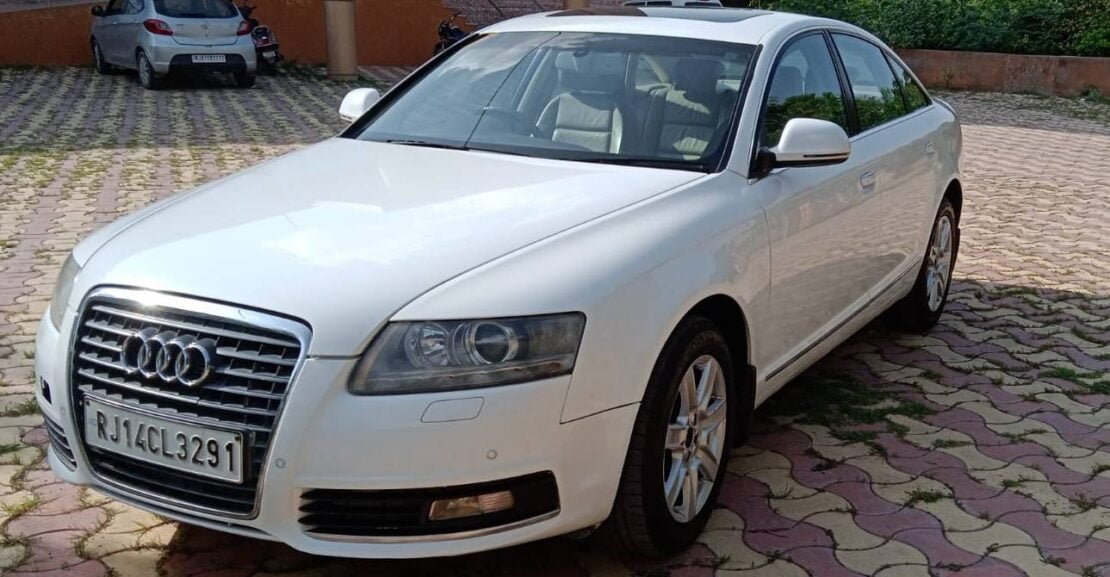The Audi A6 is usually placed between the Mercedes W211 E class and the BMW E60 5 series. It has a balance of poise and sportiness. Launched back in 2009 in India, it helped Audi portray itself as a worthy competitor of the two other German car brands.
Back in 2009, the car seemed futuristic with all the advanced technology. However, the same technology that gave Audi an edge over its competition, made it some of the worst used luxury cars to own in India.
In this article, I have covered all the common problems the Audi A6 2009-2011 has. This should help you in the used car inspection.
Timing chain tensioner failure
The Audi A6 of this era had a timing chain instead of a timing belt that can usually be found on other cars. The timing chain tensioner fails due to a lack of maintenance like avoiding the scheduled engine oil change.
As the car changes hands past its most babied years, the subsequent owners usually cut short on the maintenance part. Using a cheaper quality engine oil or even delaying the oil change and filter contributes to this failure.
If you are inspecting a car that has a good amount of vibration and lack of performance by the engine, you are dealing with an ill-maintained Audi A6. What’s next is that the rattling increases to a point where the timing chain jumps as the tensioner fails. Depending on how many teeth the chain has jumped, the performance of the engine changes. What’s more horrifying is that these engines are interfering in nature. Meaning, the piston and the valves may overlap if the timing has been altered. The result? Bent valves and busted piston heads.
The repair bills, generally, are stratospheric high after the chain has busted. Of course, engine oil changes with due diligence can altogether prevent this from happening.
Carbon deposit on the intake valve
Most of the DI (Direct Injection) cars suffer from this problem, not just only the Audi. To reduce emissions, car manufacturers had to put emission-reducing devices. One of them is the PCV (Positive Crankcase Ventilation) valve.
The PCV put all the blow-by gas and vapour back into the intake so that the engine burns cleaner, thus reducing overall emissions. In the port injection fuel system, the fuel is injected into the intake manifold where it meets its friend, air, and they go into the cylinder through the intake valve. With the detergents present in the fuel, the carbon deposit is inhibited in the port-injected cars.
Common symptoms of this problem are rough idle, misfires, poor acceleration, hesitation and stumble. And in the Audi, this should be treated at roughly 1,00,000 kilometres.
Since this is an old car and on average, it should have crossed the 1,00,000 kilometer mark, you need to check for the intake carbon deposit. Audi would charge you a sizeable amount of your salary, so find a good independent garage. The bill would be lesser for sure.
EGR valve problem
Also known as the cousin to the PCV valve, the Exhaust Gar Recirculation (EGR) helps with minimizing the emissions on a diesel-powered engine.
The EGR helps cool down the peak combustion temperature inside the cylinder reducing the production of NOx. These gases are responsible for creating smog and ground-level Ozone. Having been exposed to NOx, human beings can seriously affect their well being in the long term.
The EGR valve dumps some volume of the exhaust gases from the exhaust into the intake manifold. This exercise lowers the combustion temperature which in turn prevents the formation of NOx gases. On the other hand, over time, due to exposure to the exhaust gases, the EGR tends to clog and it may ultimately get stuck in an open or closed position.
The common symptoms of a malfunctioning EGR valve are – rough idle, black smoke from the exhaust, reduced fuel efficiency and reduced engine performance.
Cleaning the EGR valve is an easy job, and may not cost much on a friendly independent garage.
Turbo failure
Turbo is just a fan that pushes more air into the engine so that it could make more power. On this Audi, it was not the most reliable part. A turbo failure will send the vehicle into limp mode (limited power) until you repair/replace the required part.
The most common reason for the turbo failing was a failed actuator, not the main thing itself. A lot of people get it replaced but forget to get it calibrated. This only causes further problems.
The best way would be to let a sound mechanic or Audi itself handle the issue.
Failing injectors due to poor fuel quality
A common issue in all of the European cars sold in India. Not because these cars have low-quality fuel injectors, but due to the poor quality of diesel available in our country. The lack of maintenance also causes the injectors to fail. You need to change the fuel filter on diesel vehicles well before the owner’s manual recommendations!
A failing fuel injector may give these signs – bouncy tachometer needle at idle, the car may hesitate in starting, occasional gray coloured smoke from the exhaust and poor fuel efficiency.
On some simpler vehicles like the Ford Endeavour, this issue can be solved with injector cleaning agents. You can do the same if you are experiencing the said problem.
The infamous Bosche CP4 High Pressure Fuel Pump failure
Post-2008, Audi cars were equipped with a modern HP4 HPFP. It had to be reliable and more efficient than the previous technology. More efficient? Check. But more reliable? Nope.
The modern fuel pump used to use diesel as its lubricant, but with ULSD (Ultra Low Sulphur Diesel) and its leaky nature (lubricant would leak through the solenoid valve), the pump would run low on lubrication and high on friction. The increased heat would allow the metal parts to shave and send flakes into the fuel stream. The damage? The fuel stream goes into the injectors and would naturally cause them to fail over time.
Intake manifold flap may get stuck
Intake manifold flap alters the air’s volume getting to the cylinders for making a more efficient boom. And since it is an Audi we are talking about, this is actuated using an electric motor connected to a pushrod mechanism. This mechanism can last from 60,000 kilometres to 1,100,00 kilometres.
When it finally dies (the plastic pushrod generally fails), the flap may get stuck or get loose. You may get a MIL but the car can be driven on.
The crankshaft pulley failure
Common on both the BMW E60 5 series and the Audi of the same era, the crankshaft pulley fails at around the 60,000-70,000 kilometres mark. This pulley drives all the accessories. Now, as the car age (or run for the said distance), the inner part of the pulley tends to retire and ultimately divorce the outer part. When this happens, chances are that you may be left stranded.
Better to inspect the car when you are closing the 60,000-kilometre mark.
Camshaft adjustment solenoid failure
The camshaft adjustment solenoid or the timing chain tensioner keeps the cam timing in check. As they tend to fail, you will hear a tick-tick sound from the engine bank. Other symptoms are rough idle, misfires and fault codes like P0017 and P0011.
Just remember, you need to get it replaced not repaired. The part itself costs a bomb and then there is the labour cost on top of it.
Miscellaneous Problems
Cheap Plastics break
The plastic parts especially the window switch, start/stop button and the driver side door panel tend to crack after you put considerable kilometres on the car. Audi did a cost-cutting exercise and saved quite a moolah causing the customers to spend a fortune on the replacements.
Rusting
Caused by ignorance, two spots are prone to rust. The lower part of the door is concealed by the plastic moldings. The dirt gets accumulated inside it and starts rusting. The owner would only know this they carefully notice the bubble cropping up in that area (all four doors).
The second area is where the wheel well ends towards the cabin. It is one place where all the dirt gets easily collected. And a lot of owners forget to clean all this dirt when they wash their cars.
Door mounted speaker
The Audi A6 came with Bose speakers all around. You may hear a rattling sound from the front door-mounted speakers. The reason is the loose dust cover of the speaker. The glue that holds the dust cover in place loses its ability to hold two pieces together.
All you need to do is take the dust cover out and apply some adhesive and stick it back. Audi, of course, does not entertain such a request and replaces the whole unit for a kidney!
window regulator, door locks and keyless entry door handle
Seat-belt Buckle
You may hear the SBR (seat belt reminder) and see the corresponding light illuminated on the dash even if you are wearing the seat-belt. This is due to the faulty seat-belt buckle. An easy fix would be to replace it, but it costs good money.
Clogged drains
The drain on the front gets easily clogged as the vehicle mileage increases. Or if the previous owner has had a habit of parking their car under a tree, then yes, there may be hummus in the drain.
This setup directs the water from the roof channels into the car’s cabin. You may notice a water lump in the foot-well or reminiscence on the headliner.
Bluetooth failure
You may wonder that all of a sudden your MMI’s Bluetooth has stopped working. The reason may lie under the front footwell carpet. The washer fluid line goes under this area and has a Bluetooth harness in the vicinity. As the fluid starts leaking, the Bluetooth wires may come in contact with it and mess up the Bluetooth.
Air suspension life
Just like good quality dampers on any other car, air suspension on the Audi A6 has a service life of ten years. Post that, you may notice the car became a low-rider and may leave you waiting for a tow truck. The rear may even fail before the ten-year mark.
At this age, make sure that the suspension has been serviced.

